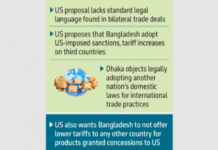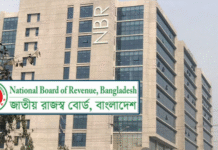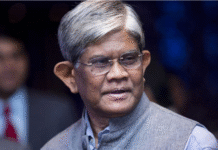

Debt servicing has become a rising concern for developing countries in recent times. With sluggish growth worldwide, the havoc caused by Covid-19 over the past three years, and global economic instability due to the ongoing war in Ukraine, the revenues of governments in developing countries are sliding down, and the need for them to borrow is rising. As a result, debt repayment (principals and interests), as a ratio of either revenues or gross national income (GNI), has been becoming more and more difficult. For example, with the advent of Covid, the average ratio of external debt to GNI for developing economies (excluding China) jumped by 13 percentage points to 44 percent in 2020, as a result of which, developing countries had to struggle to retain their pre-Covid human development expenditures.
The concern for debt servicing has been echoed in the case of Bangladesh too. During the last fiscal year, the debt service to revenue ratio in Bangladesh rocketed to 81 percent, which was 56 percent in the pre-pandemic year. The increased level of debt service to revenue ratio means that today, if the government earns Tk 100 in taxes, it has to spend more than Tk 81 to pay off loans, as opposed to Tk 56 in 2019. This simply implies that because of higher debt servicing payment, there would be less availability of resources for development and other priority expenditures, including those required for post-pandemic economic recovery. This will put pressure on public finance. Resources that could have been spent on essential sectors like health, education or public investment are now being dedicated to interest payments.
Debt repayment has to be undertaken with regard to domestic debt as well as external debt. In this context, three points are important. First, while domestic debt can be paid in terms of domestic revenue, foreign debt has to be paid in terms of foreign exchange accumulated through export earnings. Second, because of its nature, the government may have more flexibility in managing domestic debt servicing compared to external debt servicing. And third, sometimes, governments put more focus on external debt compared to domestic debt, even though domestic debt may be substantial. In Bangladesh, total public debt stood at USD 148 billion in fiscal year 2021, about 41 percent of GDP. Of this, external debt accounted for USD 62 billion, or 18 percent of GDP.
An in-depth look at the debt servicing of Bangladesh raises some structural public debt issues. First, interest payments on debts remain high because of higher rates on national saving certificates, expensive bank borrowing, delay in executing the projects, and irrelevance and overvaluation of projects. For example, the government provides higher rates of interest on national savings certificates due to the fact that people have limited sources for investing their hard-earned money. As a result, they opt to invest in risk-free national savings certificates, leading to a rise in government borrowing from expensive sources.
Second, because of revenue constraints, the government has opted to borrow more in recent years, including through non-concessional and hard-term loans from foreign lenders, resulting in higher repayments. The borrowing has been undertaken to finance current expenditures, but also to service existing debts, accounting for the largest part of the expenditure. Sometimes, the government has to borrow to finance big projects, the debt repayment on which is also substantial.
Third, in many cases, some multilateral and bilateral donors have increased their interest rates and service charges, but have reduced the grace periods. For example, the World Bank, Bangladesh’s largest multilateral donor, has reduced the maturity period of its loans from 40 years to 30 years and grace period from 10 years to five to seven years, respectively. The government has also taken some hard loans from bilateral donors like China and Russia. Overall, the country needed to repay its interest and principal amounts simultaneously, resulting in repayment amounts to increase year-to-year.
Fourth, with Bangladesh graduating from the Least Developed Country (LDC) status, borrowing and debt repayment would become harder for Bangladesh in the future. In fact, since 2016, when Bangladesh graduated to a lower middle-income country (LMIC) category, loans started to get costlier. For example, the Asian Development Bank (ADB), the second largest multilateral donor of Bangladesh, has enhanced lending from its non-concessional window. Since Bangladesh became a LMIC, the loans from ADB’s soft window—the Asian Development Fund—have been decreasing year-on-year. Japan, the largest bilateral donor of Bangladesh, has also made its lending terms harder—as it’s been charging 0.10 percent interest rate in recent years against 0.01 percent a few years back.
Fifth, the average revenue mobilisation is quite weak in Bangladesh. In fiscal year 2021, the revenue mobilisation in Bangladesh was around 10 percent of its GDP. It is less than half of that of 25 percent in emerging and developing Asian countries. The revenue-GDP ratio in Nepal is 22 percent, In India, it is 20 percent and, in Pakistan, it is 15 percent. Therefore, Bangladesh has a lot of catching up to do.
In the context of the preceding discussion, a crucial question is: Is debt servicing at risk in Bangladesh? The answer is “no”. Bangladesh’s public debt at 41 percent of its GDP is way lower than the risk threshold of 70 percent estimated by the International Monetary Fund (IMF). The external debt service to revenue ratio in the country reached 10 percent in 2020, but it is still below the risk threshold of 23 percent. In Bangladesh, all external debt indicators are below their corresponding risk thresholds under the most extreme shock scenario, and the risks of debt distress remains low.
But there is no place for complacency. Bangladesh needs to be cautious about its debt and debt servicing. Even though the amount of external debt is still far below the risk threshold, Prime Minister Sheikh Hasina recently directed all concerned authorities to take necessary measures to ensure the maintenance of the country’s current position in future, regarding external debt.
Measures must be taken both on the revenue and the debt front. On the revenue front, the tax-base of Bangladesh must be expanded. The government had set an annual revenue collection target of 13.5 percent of GDP in 2020. Yet, last year, the actual revenue collection of Bangladesh was 9.4 percent of GDP. The government has expressed its commitment towards automating revenue administration and tax expenditure rationalisation. Thus, widening the tax base would require using technology for tax enforcement, while reducing expenditures on losing state-owned enterprises. The issue of export-diversification is a long-standing issue in Bangladesh. With global growth being sluggish, this is extremely important for Bangladesh if foreign exchange revenue is to be enhanced.
On the debt side, Bangladesh should continue seeking concessional financing to the extent that is possible, even though with LDC graduation it may prove to be a major challenge for the country. After graduation, Bangladesh would have to borrow loans at higher rates, which would further increase its debt-repayment amounts in the near future. In that context, the country should also look to attract non-debt creating financial inflows, such as foreign direct investment (FDI). Furthermore, Bangladesh should ensure best use of the costly loans through quality implementation of projects as well as checking misuse and leakage of funds. Domestic borrowing should be further scrutinised, as it costs the economy more because of borrowing at higher commercial rates.
As far as the debt servicing of Bangladesh is concerned, right now, there is no need for anyone to panic. However, the country needs to be cautious so that unforeseen future shocks does not create any debt distress.
Selim Jahan is a former director of the Human Development Report Office and Poverty Division at the UNDP.









